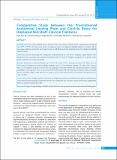Please use this identifier to cite or link to this item:
https://hdl.handle.net/20.500.14356/1111Full metadata record
| DC Field | Value | Language |
|---|---|---|
| dc.contributor.author | KC, Kapil Mani | - |
| dc.contributor.author | Acharya, Parimal | - |
| dc.contributor.author | RC, Dirgha Raj | - |
| dc.contributor.author | Marahatta, Suman Babu | - |
| dc.contributor.author | Niroula, Ankit | - |
| dc.contributor.author | KC, Amuda | - |
| dc.date.accessioned | 2023-04-24T07:07:56Z | - |
| dc.date.available | 2023-04-24T07:07:56Z | - |
| dc.date.issued | 2021 | - |
| dc.identifier.citation | KCK. M., AcharyaP., RCD. R., MarahattaS. B., NiroulaA., & KC A. (2021). Comparative Study between the Precontoured Anatomical Locking Plate and Clavicle Brace for Displaced Mid-Shaft Clavicle Fractures. Journal of Nepal Health Research Council, 19(2), 337-342. https://doi.org/10.33314/jnhrc.v19i2.3234 | en_US |
| dc.identifier.issn | Print ISSN: 1727-5482; Online ISSN: 1999-6217 | - |
| dc.identifier.uri | http://103.69.126.140:8080/handle/20.500.14356/1111 | - |
| dc.description | Original Article | en_US |
| dc.description.abstract | Abstract Background: Most of the midshaft clavicle fractures heal conservatively without further complications with union rate of 94 to 99.7%. Several recent studies recommend surgery for displaced midshaft fracture, to reduce risk of non-union malunion and clavicle shortening. So there is still dilemma for the optimal treatment for displaced midshaft clavicle fracture. Methods: This was the prospective comparative study performed in Civil Service Hospital, Nepal. Patients were divided into the two groups each containing 40 patients and were treated with figure of eight brace for group 1while group 2 patients were treated surgically. Results: Mean time to unite the fracture was 11.87±1.78 versus 11.55±1.46 weeks (P value 0.37). There were 14 (35%) cases of malunion more than 10 degree in group 1 and 1 (2.5%) malunion in group 2 (P value 0.001). Twenty nine (72.5%) patients in group 1 and 35 (87.5%) in group 2 were fully satisfied one year after treatment Constant and Murley score in group 1 were 75.22±2.85, 90.87±3.39 and 96.30±1.80 at the time of fracture union, six month and one year after surgery while that score in group 2 were 81.67±2.86, 93.87±2.17, 98.20±1.20 respectively ( P value <0.001). Conclusions: There is higher incidence of nonunion, symptomatic malunion and inferior perception of satisfaction in conservatively treated patients. Functional outcomes are comparable one year after surgery, however it is significantly better in operative group before that. Keywords: Figure of eight bandage; midshaft clavicle fractures; non-operative treatment; precontoured locking plate | en_US |
| dc.language.iso | en | en_US |
| dc.publisher | Nepal Health Research Council | en_US |
| dc.relation.ispartofseries | Apr-June, 2021;3234 | - |
| dc.subject | Figure of eight bandage | en_US |
| dc.subject | midshaft clavicle fractures | en_US |
| dc.subject | non-operative treatment | en_US |
| dc.subject | precontoured locking plate | en_US |
| dc.title | Comparative Study between the Precontoured Anatomical Locking Plate and Clavicle Brace for Displaced Mid-Shaft Clavicle Fractures | en_US |
| dc.type | Journal Article | en_US |
| local.journal.category | Original Article | - |
| Appears in Collections: | Vol. 19 No. 2 (2021): Vol 19 No 2 Issue 51 Apr-Jun 2021 | |
Files in This Item:
| File | Description | Size | Format | |
|---|---|---|---|---|
| 3234-Manuscript-23775-1-10-20210907.pdf | Fulltext Download | 223.71 kB | Adobe PDF |  View/Open |
Items in DSpace are protected by copyright, with all rights reserved, unless otherwise indicated.
